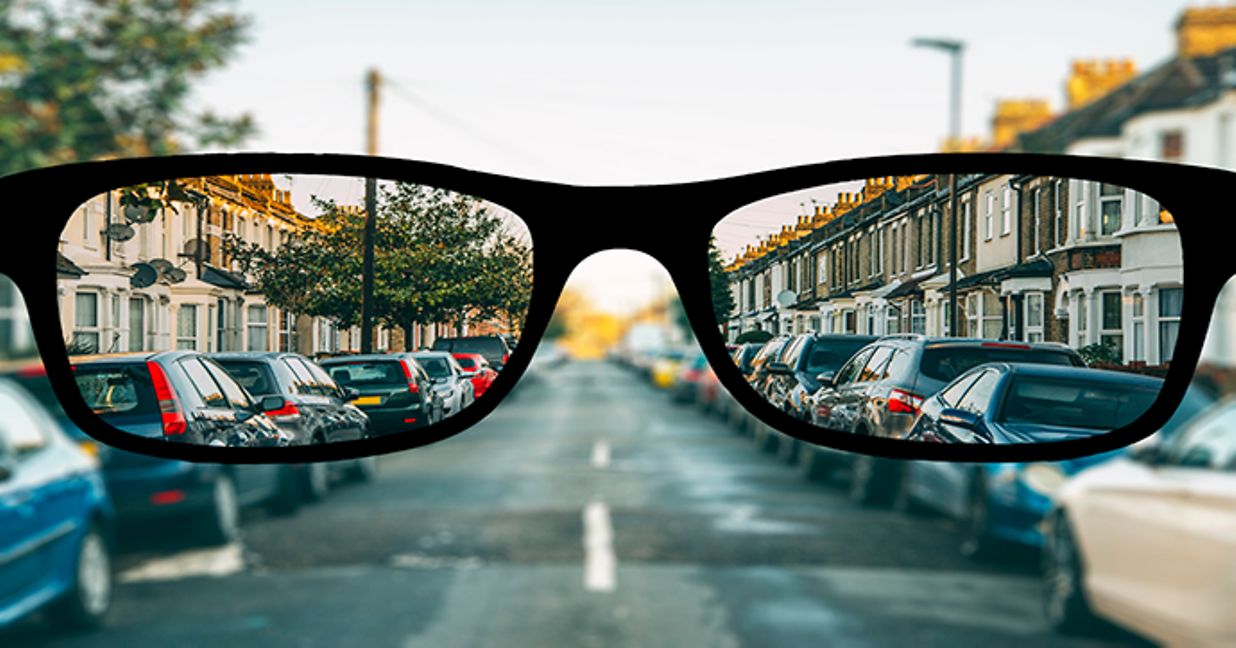When you hear the words “near” and “far,” what comes to mind? Maybe it’s Sesame Street’s® classic Grover skit, where the Muppets™ character explains the concept, frantically running to and from the camera. If you’ve never seen it, it’s sure to make you smile.
Or ... maybe it’s your eyesight. Internet search data reveals there’s a lot of confusion over the meaning of “nearsighted” and “farsighted.” You’ll see a lot of people Googling questions like “If I’m nearsighted, does that mean I can see what’s near to me? Or does it mean I need help seeing things up close?" One thing’s clear —many people have questions about these conditions and how they affect vision.
We’re here to help.
Myopia (aka nearsightedness):
Nearsightedness is actually called myopia, and those with it can see well up close, but far-away objects are blurry. For example, if you struggle to see whiteboard presentations in the conference room at work, you might be experiencing myopia. (1) And you wouldn’t be alone. Nearly 30% of Americans have it, likely inherited or caused by how a person uses his or her eyes. People who do a lot of close visual work, including computer work, might be more prone to myopia. (1)
Here’s why: myopia is caused when the eyeball is too long or the cornea (the transparent layer covering the front of the eye) is too curved. In either case, when light from a distance enters the eye, it doesn’t focus properly, creating the blurriness — myopia. (1)
Someone with myopia can manage the condition by wearing eyeglasses or contact lenses to improve distance vision; or, there are surgical remedies, including laser procedures such as LASIK or PRK, that can reshape a patient’s cornea to refocus light as it enters the eye. Meanwhile, orthokeratology, or corneal refractive therapy, is a non-surgical option for gradually reshaping the cornea. Consulting with an eye doctor is the best way to determine the optimal treatment choice. (1)
Hyperopia (aka farsightedness)
A comprehensive eye exam also will test for hyperopia, commonly referred to as farsightedness, which affects about 25% of Americans. Those with hyperopia can see well at a distance, but might struggle to focus on objects up close. (2)
For individuals with hyperopia, close-range work can lead to squinting, headaches and eye strain. The condition is caused because light rays focus behind the retina instead of on the retina. A person with hyperopia has a shorter eyeball than normal, and the condition can be detected through the same tests that uncover myopia. (2)
People with hyperopia will have corrective-lens prescriptions that begin with a plus number, and they might need to wear lenses to read or work on a computer. As with myopia, patients with hyperopia might be able to elect surgical vision correction as an alternative to wearing lenses. (2)
How does the doctor determine which one it is?
A comprehensive eye exam tests for myopia and hyperopia in several ways. The most well-known is the chart when the patient reads the smallest letters he or she can see clearly. The resulting measurement of visual acuity is written as a fraction and 20/20 is the standard for normal vision. The top number indicates the distance from which the test is performed, and the bottom is the smallest letter size the patient can read. (1)
During an eye exam, the doctor also will use an autorefractor to measure how the eyes focus light, and a phoropter which places various lenses in front of a patient’s eyes to measure the refractive error amount. The eye doctor might use an automated instrument to evaluate how well the eye focuses. (1)
Next steps--what you can do
Now you know the difference between near and farsightedness and how they’re identified. But did you also know myopia (nearsightedness) is now being called a global epidemic among kids? Check out this EyeMed story on kids and myopia and/or this infographic from All About Vision.
As an employee benefits professional, you’re in a unique position to help educate and make a difference. You can ensure employees have access to vision benefits offering an annual comprehensive eye exam, eyeglasses and contacts to keep up to date on their eyewear prescription, the latest lenses and new eye care technology.
With easy-to-use and comprehensive benefits and some basic education, it’s easier to manage nearsightedness, farsightedness and all the other vision conditions in between.
For more information on EyeMed Vision Care, visit starthere.eyemed.com.
BL-1811-CB-894
1. American Optometric Association, “Myopia (Nearsightedness).” Accessed Oct. 5, 2018.
2. All About Vision, “Hyperopia (Farsightedness),” 2017. Accessed Oct. 5, 2018.




